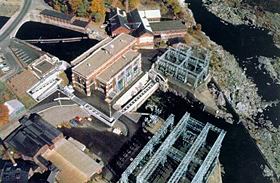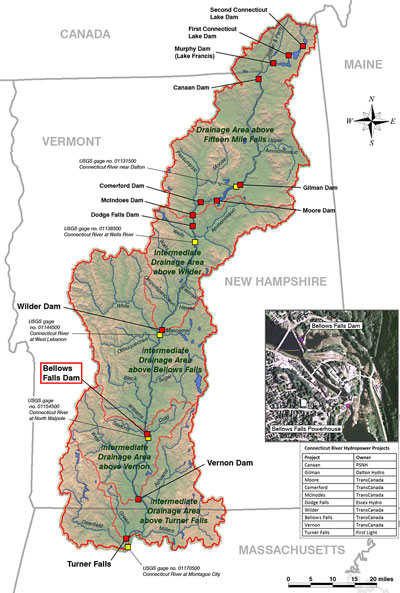Bellows Falls Project FERC No. 1855
Location

The Bellows Falls Project, FERC No. 1855, is located on the Connecticut River at river mile 173.7 and extends upstream approximately 26 miles. The dam and powerhouse is approximately 1 mile upstream of the Saxtons River and 3 miles downstream of the Williams River.
State or Territory: New Hampshire and VermontCounty: NH – Sullivan and Cheshire, VT – Windsor and Windham
Township or nearby town: NH – Walpole, VT – Rockingham
The installed capacity of the Project is: 40,800 kW.
Project Works
Project works consist of:
- A concrete gravity dam 643 feet long and 30 feet high, having a gated spillway with two roller gates and three stanchion flashboard bays;
- Bellows Falls reservoir, extending 26 miles upstream, having a surface area of 2,804 acres at normal full pond elevation of 291.63 feet msl;
- a power canal 1,700 feet long with a forebay intake area and sluice gate;
- a tailrace approximately 900 feet long;
- a powerhouse containing three generating units, each rated at 13,600 kW;
- transmission interconnection facilities consisting of:
- generator leads to the 6.9-kV bus;
- the 6.9-kV bus;
- Nos. 1 and 2 step-up transformers, rated 6.9/115 kV;
- fish passage facilities; and
- appurtenant facilities.
History and Amendments
The original license for the Bellows Falls Project was issued by the Federal Energy Regulatory Commission (FERC) jointly to New England Power Company, Bellows Falls Hydro-Electric Corporation, and the Connecticut River Power Company on October 13, 1943. New England Power Company subsequently purchased all of the physical properties and franchise of Bellows Falls Hydro-Electric Corporation and became the Licensee, as authorized by FERC under its Order dated July 9, 1948.
In 1962, land easements and deeds were granted to the Village of Bellows Falls, Vermont, and in 1963, to the town of Charlestown, New Hampshire, for construction of wastewater treatment facilities. In 1964, land was deeded to the state of Vermont for construction of Interstate Highway 91. Land has also been leased to the state of Vermont since 1965 for a waterfowl nesting area adjoining Bellows Falls reservoir, and in 1964, land on the reservoir was deeded to the state of Vermont for boat launching and docking facilities.
The original license expired on June 30, 1970. The Project operated under annual licenses until the license was renewed on August 3, 1979. The 1979 license remains in effect and expires on April 30, 2019 after FERC granted a one year extension on July 22, 2015.
On October 5, 1978, FERC approved a settlement agreement concerning fish passage facilities for American shad and Atlantic salmon at the Project, and at two other projects - Wilder (Project No. 1892) upstream, and Vernon (Project No. 1904) downstream. The settlement was executed on December 30, 1977, among the Licensee, the States of Massachusetts, Connecticut, New Hampshire and Vermont, US Fish and Wildlife Service (FWS), and four non-governmental organizations (the Environmental Defense Fund, the Massachusetts Public Interest Research Group, Inc., For Land’s Sake, and Trout Unlimited). The settlement called for staged design, construction and operation of passage facilities at the three Projects, with Bellows Falls’ construction schedule being dependent upon a trigger number of 30 returning adult salmon to the downstream Holyoke Project (Project No. 2004). The upstream fish way was subsequently completed and commenced operation in 1984.
On July 26, 1990, the Licensee entered into a Memorandum of Agreement with the Connecticut River Atlantic Salmon Commission (CRASC) for permanent downstream fish passage facilities for the Wilder, Bellows Falls and Vernon Projects. A downstream fish diversion boom was installed in 1996, and passage is provided via the forebay sluiceway/skimmer gate, and by a supplemental sluice pipe.
On February 27, 1998, FERC approved the transfer of the license from New England Power Company to USGen New England, Inc. Under a multi-license amendment dated November 19, 1998, regional electrical transmission facilities were removed from the Project including three multi-wound step-up transformers. At that time, the station was automated and began operations via remote control from the Connecticut River Control Center in Wilder, Vermont.
On January 21, 2005 FERC Approved a change in the Bellows Falls Project Boundary, which removed a small piece of land with an office building (presently the TransCanada North Walpole office) from the Project. On January 24, 2005, FERC approved the transfer of the license to TransCanada Hydro Northeast Inc. On February 5, 2005, FERC approved another Project Boundary change, which removed 8.8 acres and historic structures from the Project boundary to facilitate subsequent transfer to the Bellows Falls Historical Society.
On April 19, 2017, Great River Hydro, LLC acquired all of TransCanada's New England hydroelectric power portfolio which included the Bellows Falls Project.
Relicensing
About Great River Hydro
Great River Hydro is New England’s largest conventional hydropower generator. Go to www.greatriverhydro.com for more information.
© 2024 Great River Hydro, LLC

